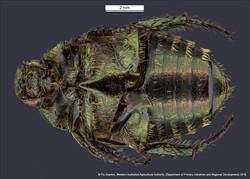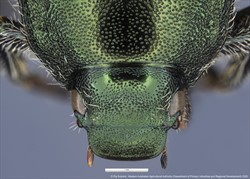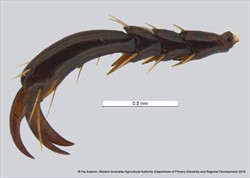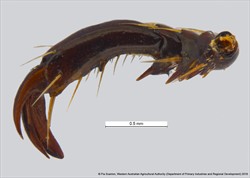Sub family: Rutelinae / Tribe: Anomalini / Genus: Popillia
Fact Sheet
Popillia japonica Newman, 1838
Small to medium, broadly oval beetles, body length 8-15mm. Body colouration metallic green, with coppery elytra. Distinct patches of pale setae on lateral margins of abdomen and the pygidium. Clypeus with apex subquadrate or rounded. Antennae with 9 segments, and a 3-segmented club. Frontoclypeal suture complete. Pronotum with base tridentate and with an apical membraneous margin. Mesepimeron visible dorsally. Elytra with a membraneous border along lateral margins. Mesometasternal process present, projecting forward beyond base of mesocoxae. Protibia bidentate, with a subapical spur. Front and mid tarsi with a cleft claw, hind claws simple.
The adults lay their eggs in the soil in grassy areas. The emerging C-shaped larvae feed first on the thin grass roots and later with maturity on increasingly thick roots occasionally causing damage. In extreme cases, the symptoms can be in the form of large brown patches that appear during dry weather.
Though larvae can cause some feeding damage, adult beetles are the primary pestiferous form that are capable of feeding on nearly 300 plant species across 79 families. They are often skeletonising foliage of many fruit trees and grapes, and in corn crops they can cause severe damage by feeding on the silk (the style of a maize floret).
Popillia japonica has also been recorded as facilitating and increasing the pest status of other beetles. By feeding on intact grapes they allow the fruit to be exploited by other beetles, such as Cotinis nitida in the United States whose mouthparts are unsuitable for peircing the fruits skin (Hammons et.al. 2009). Injured fruit can also produce attractant volatiles causing potential for further fruit damage.
The species is native to Japan and far eastern Russia. It has since spread outside it's native range into the USA, Canada, China, India, Korea, Tawain and Portugal. It is absent from Australia.
Once it was introduced to the USA the extensive, well-watered turfed areas and a lack of parasites allowed populations to rapidly build up and spread. The species has proved to be very adaptable, moving considerably outside of their native climatic conditions.
Scarabs of Hawaii Fact Sheet: http://idtools.org/id/beetles/scarab/factsheet.php?name=15216
EPPO Diagnostic Protocol (pdf): https://onlinelibrary.wiley.com/doi/epdf/10.1111/j.1365-2338.2006.01039.x
UFL Fact Sheet: http://entnemdept.ufl.edu/creatures/orn/beetles/japanese_beetle.htm
Plant Health Australia Fact Sheet (pdf): http://www.planthealthaustralia.com.au/wp-content/uploads/2013/09/Japanese-beetle-FS.pdf
CABI 2018. Popillia japonica (Japanese Beetle). Invasive Species Compendium. Wallingford, UK, CABI International. Available from https://www.cabi.org/isc/datasheet/43599
Fleming, W.E. 1972. Biology of the Japanese beetle. USDA Technical Bulletin 1449, Washington, DC.
Hammons, D.L., Kurtural, S.K., Newman, M.C., & Potter, D.A. (2009). Invasive Japanese beetles facilitate aggregation and injury by a native scarab pest of ripening fruits. Proceedings of the National Academy of Sciences of the United States of America, 106(10), 3686–3691.
Johnson, W.T., Lyon, H.H. 1991. Insects that Feed on Trees and Shrubs. Comstock Publishing Associates, Cornell University Press, Ithaca and London.
Potter DA, Held DW. 2002. Biology and management of Japanese. Annual Review of Entomology 47: 175-205.









